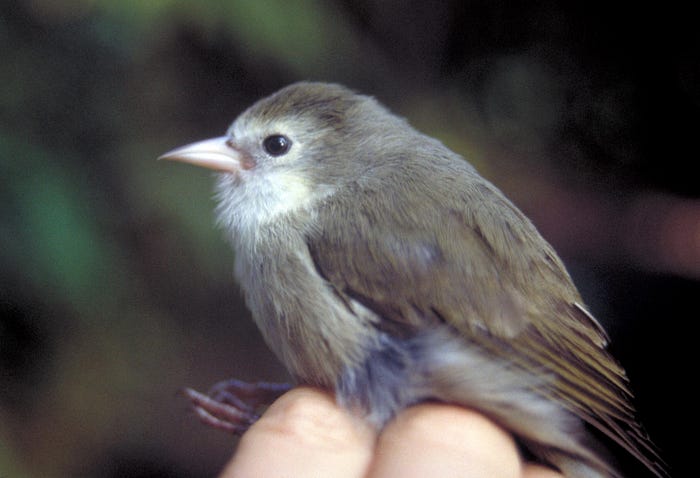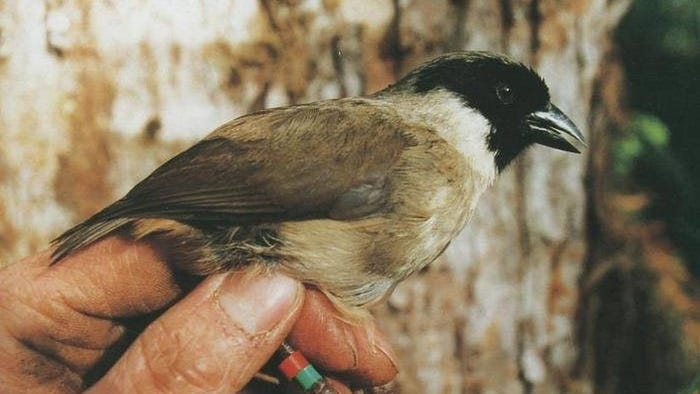© by GrrlScientist for Forbes | LinkTr.ee
The U.S. Fish and Wildlife Service announced recently that they will delist 21 species from the Endangered Species Act because they are extinct. Found in 16 states and in the U.S. territory of Guam, most of these species were listed under the ESA in its early days in the 1970s and 80s, and had very low numbers or were likely already extinct when listed.
According to the statement, one mammal (the Little Mariana fruit bat from Guam), eight freshwater mussels from the Eastern Seaboard, two freshwater fish and 10 birds were declared extinct after being listed as critically endangered for decades. Eight of the delisted birds were endemic to Hawaii, with the po'ouli, Melamprosops phaeosoma, or black-faced honeycreeper, last seen in 2004, making it the most recently sighted of the delisted — and now extinct — species.
Other Hawaiian birds may soon become extinct too: after the massive wildfires triggered by climate breakdown roared across much of Maui, the critically endangered ʻAkikiki, Oreomystis bairdi, or Kauaʻi honeycreeper, is now reported to have a population of just five individuals (ref), down from a total of 454 wild individuals reported in 2018 (ref).
"Few people realize the extent to which the crises of extinction and climate change are deeply intertwined," said Noah Greenwald, endangered species director at the Center for Biological Diversity.
"Both threaten to undo our very way of life, leaving our children with a considerably poorer planet. One silver lining to this sad situation is that protecting and restoring forests, grasslands and other natural habitats will help address both."

"Federal protection came too late to reverse these species' decline, and it's a wake-up call on the importance of conserving imperiled species before it's too late," said USFWS Director Martha Williams in a statement.
These extinctions highlight the importance of the ESA and efforts to conserve species before declines become irreversible. The circumstances of each extinction also underscores how human destructiveness can drive species declines and extinctions through habitat loss, shooting and other forms of exploitation, the introduction of invasive species, particularly cats, rats and pigs, and diseases.
A total of 650 species have already been listed as extinct in the United States, according to the Center for Biological Diversity, a national U.S. nonprofit wildlife conservation organization (ref). Scientists have been warning the public for decades that Earth is experiencing a mass extinction event, which is defined as the loss of more than 75% of its species (more here) in less than 2.8 million years. Unlike the previous mass extinctions, which resulted from extreme temperature changes, rising or falling sea levels and catastrophic, single events such as huge volcanic eruptions or an asteroid crashing into Earth, this current mass extinction event is solely due to human destruction.
"As we commemorate 50 years of the Endangered Species Act this year, we are reminded of the Act's purpose to be a safety net that stops the journey toward extinction," Ms Williams reminded us in a statement.
"The ultimate goal is to recover these species, so they no longer need the Act's protection."
The ESA has generally been highly effective and is credited with saving 99% of listed species from extinction. Thus far, more than 100 species of plants and animals have been delisted based on recovery or reclassified from endangered to threatened based on improved conservation status, and hundreds more species are stable or improving, thanks to the collaborative actions of Tribes, federal agencies, state and local governments, conservation organizations and private citizens.
The final rule to delist these 21 species from the ESA due to extinction will be published today, 17 October 2023, in the Federal Register and will go into effect in 30 days.
Two Reprieves
Two endangered species were granted a temporary reprieve. After the USFWS proposed to delist 23 species in September 2021, public comments informed them that two species may yet cling to life. The first, a Hawaiian perennial mint, Phyllostegia glabra var. lanaiensis, may possibly still be found in newly identified, potentially suitable habitats for the species.

The other species, the ivory-billed woodpecker, Campephilus principalis, also known by a variety of common names including the Lord Gawd Bird, because it was the largest woodpecker species in the United States, is still under review. Despite the intense squabbling over this bird's fate amongst bird watchers (and even a few professional ornithologists) over the past 20 years, along with hundreds of thousands of hours of exhaustive searching by hundreds of skilled observers, nothing definitive has ever been reported, making it likely this bird is truly gone forever. This dramatic species is likely extinct due to uncontrolled shooting and rampant logging of old-growth bottomland hardwood forests and old-growth temperate coniferous forests of the Southeastern United States and Cuba, where it lived.
Socials: Bluesky | CounterSocial | LinkedIn | Mastodon | MeWe | Post.News | Spoutible | SubStack | Tribel | Tumblr | Twitter
SHA-256: 9ab94921e06b203a216cb219d873f92ea4083642075e2e0be632939cd42949aa
Originally published at Forbes.com on 17 October 2023. Keep up with my writing with my free newsletter. (Sporatically emailed.)


